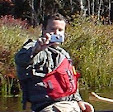If you spend enough time playing in rocks you will eventually come out of the boat. How you respond depends on the conditions you are in and the availability of help.
The first order of business if you come out of your boat in the rocks is to get yourself into a safe position. You never want to be in between the rocks and the boat, so position yourself with the kayak between you and the rocks. Once you are in a safe position, you can begin to think about how to get out.
Swimming out is a proactive way to get yourself to safer water. If the distance is short, you can simply grab the boat and go. Flip the boat over, swim to the end of the boat furthest away for the rocks, grab the toggle, and aggressively swim out of the feature. You can either stow your paddle in the deck lines or hold it in your hands as you swim.
If the distance is longer, it may be easier to attach your tow line. Once again, get to the end of the boat furthest from the rocks, clip on your tow line and go. Once in calmer water you can pull in the boat, unclip and tuck the towline in your PFD to prevent it from getting tangled in the rocks, and do a self or assisted rescue.
If someone is nearby and the distance is short you can do a toggle tow. Flip your boat over, and move to the toggle at end furthest from the rocks. The rescuer paddles in and presents the bow or stern toggle for the swimmer to grab, and paddles out of the feature. Once in calmer water you can do an assisted rescue
If conditions are rough it might be better for the rescuer to use the tow line. The swimmer gets in the safe position on the rescuer’s boat while the rescuer clips the tow line on the swimmers boat and paddles out. Once in calmer water you can pull the boat to you and do an assisted rescue.
Once the rescuer has the swimmer out of the rocks, it is often helpful to have a third member of the team clip on to the rescuer’s boat for an anchor tow that prevents them from drifting back into the rocks during the rescue.






























